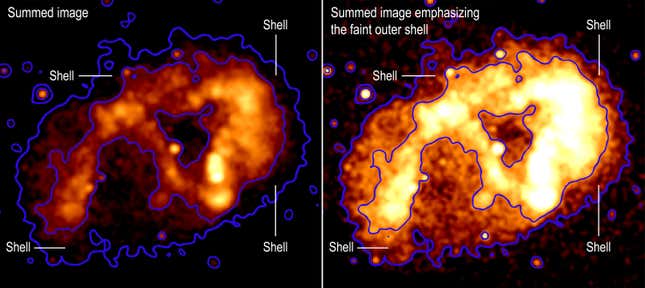The Chandra X-ray Observatory didn’t exist in 1838, when the Eta Carinae star system started to brighten as it ejected material in an event named the “Great Eruption.” But traces of the eruption remain, and a timelapse has now been created by compiling 20 years of the space telescope’s data to showcase the dynamic environment surrounding the system’s two stars.
The Chandra X-ray Observatory launched to space in July 1999 and took up residence in Earth orbit, about 86,500 miles (139,000 kilometers) into space. Since then, the telescope has observed many cosmic sights at X-ray wavelengths, revealing new information about everything from star formation to the black holes that sit at the heart of galaxies.
Advertisement
Eta Carinae is about 7,500 light-years from Earth in the constellation Carina. You may recognize that name, as one of the Webb Space Telescope’s first images was a stupendous vista of the Carina Nebula’s “Cosmic Cliffs”, a gassy star-forming region of the nebula.
The timelapse video is compiled from Chandra frames of Eta Carinae taken in 1999, 2003, 2009, 2014, and 2020. The blue light at the center of the structure represents the two stars in Eta Carinae, emitting high energy X-rays. The surrounding orange bits are also from bright X-rays, but part of the nebulous gas cloud surrounding the two stars.
Advertisement
Advertisement
Now, a team of researchers directly measured the expansion of the X-ray shell that surrounds Eta Carinae and the two voluminous gas clouds that surround it. Their research was published in The Astrophysical Journal.
“We’ve interpreted this faint X-ray shell as the blast wave from the Great Eruption in the 1840s,” said study lead author Michael Corcoran, an astrophysicist at NASA’s Goddard Space Flight Center, in a Chandra release. “It tells an important part of Eta Carinae’s backstory that we wouldn’t otherwise have known.”
When the Great Eruption occurred, Eta Carinae—composed of two stars, which are 30 and 90 times the Sun’s mass, respectively—ejected between 10 and 45 times the Sun’s mass. That material formed spherical gas clouds which were dubbed the Homunculus nebula.

Advertisement
The team found that, just like the Homunculus nebula, the X-ray shell of the system probably originated from the Great Eruption. The researchers posit that material had already been ejected from the system centuries before the Great Eruption and that older material was illuminated by X-rays when the Great Eruption occurred.
“The shape of this faint X-ray shell is a plot twist in my mind,” said study co-author Kenji Hamaguchi, a researcher at the University of Maryland and NASA Goddard, in the same release. “It shows us that the faint shell, the Homunculus, and the bright inner ring likely all come from eruptions from the star system.”
Advertisement
The team concluded that the Great Eruption was likely two separate explosions: first, the outburst of low-density gas that also emitted X-rays, and then an ejection of dense gas that formed the Homunculus nebula. The Great Eruption itself may have been caused by a stellar merger—meaning that Eta Carinae was once a triple star system, not the binary system it is today.
Future observations may shed more light on the origin of the explosion, even if the timelapse doesn’t. But the video is a cool way of seeing the dynamic nature of the cosmos from the still, somewhat sterile, shots we normally see.
Advertisement
More: Watch Four Planets Spin Around a Star 130 Light-Years Away
Services Marketplace – Listings, Bookings & Reviews